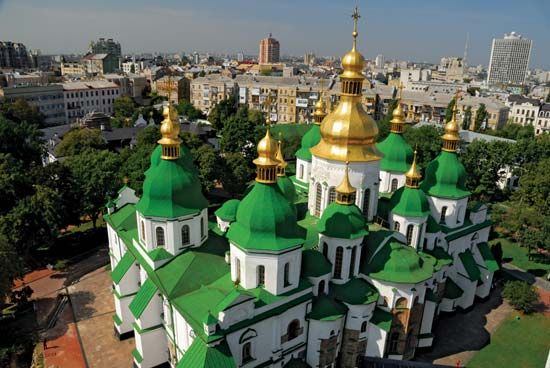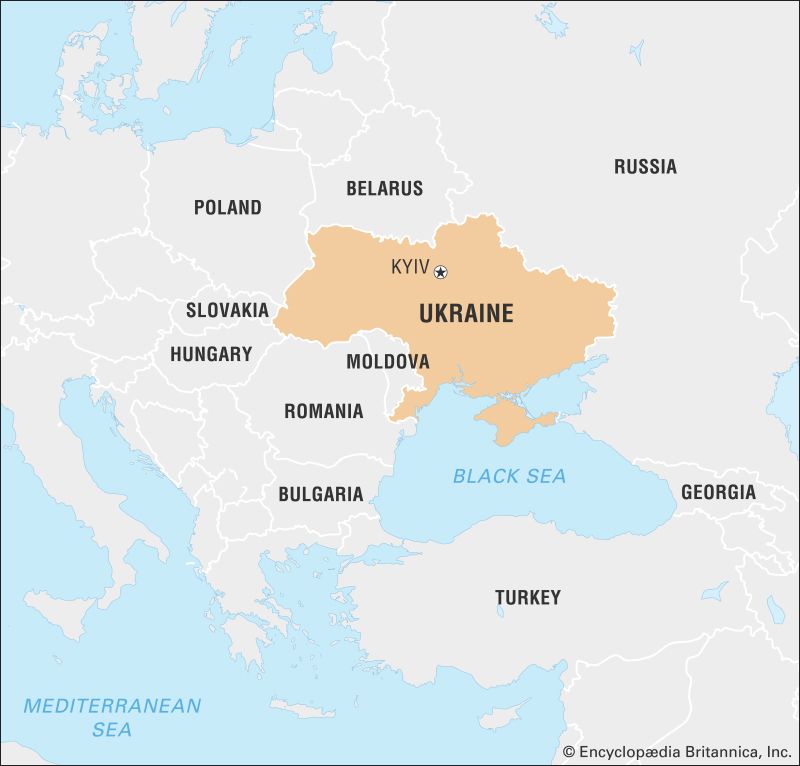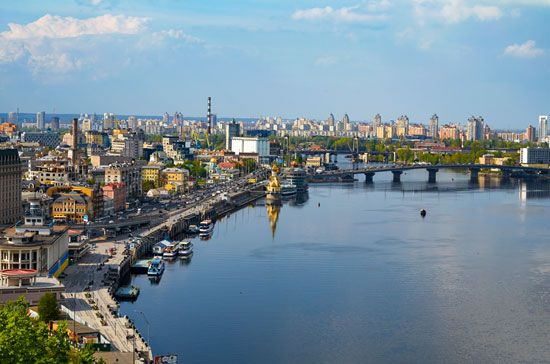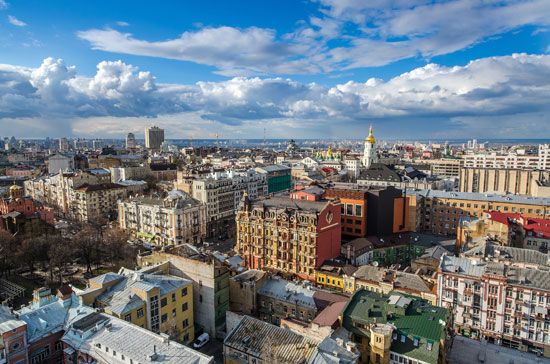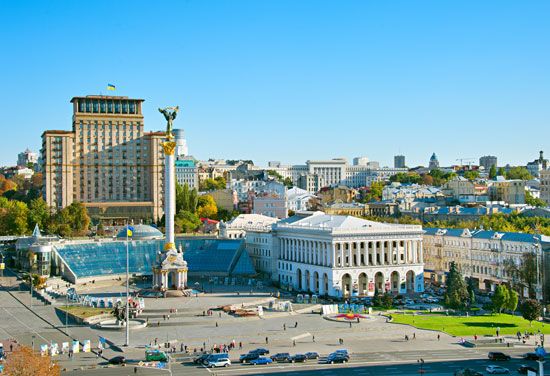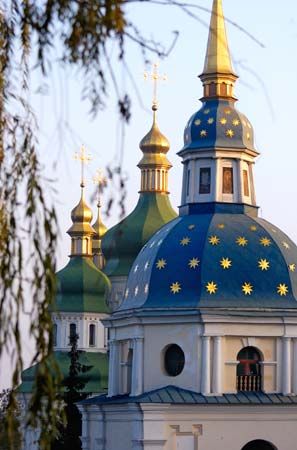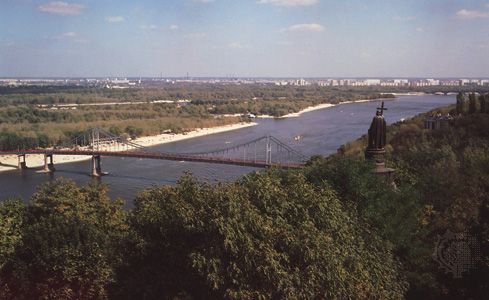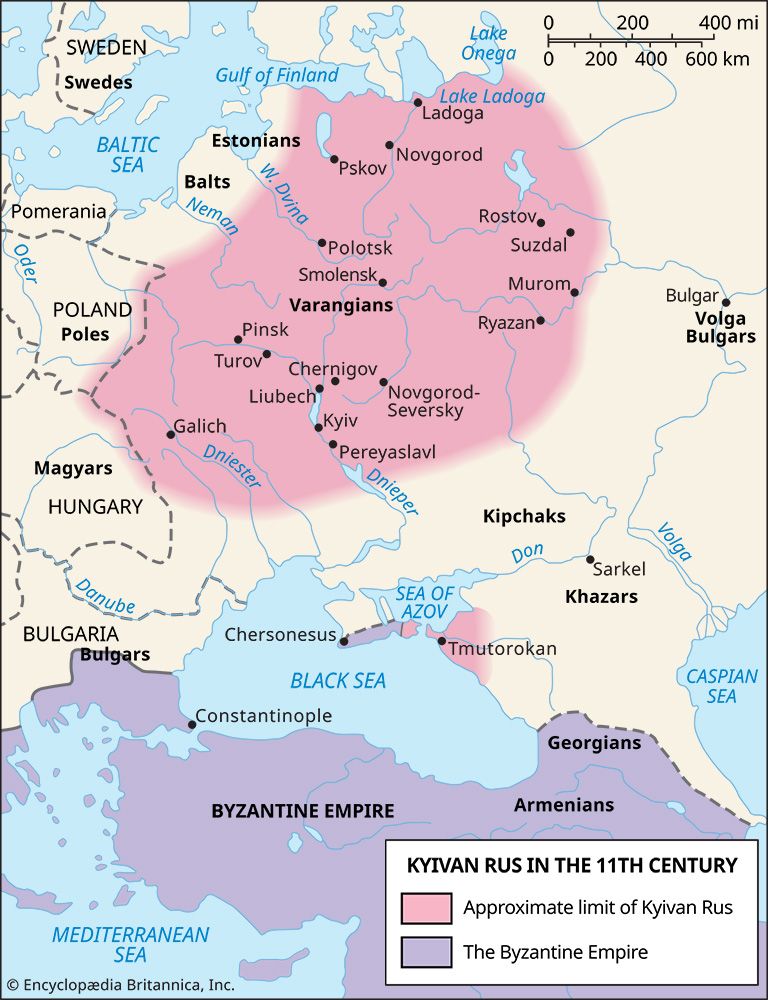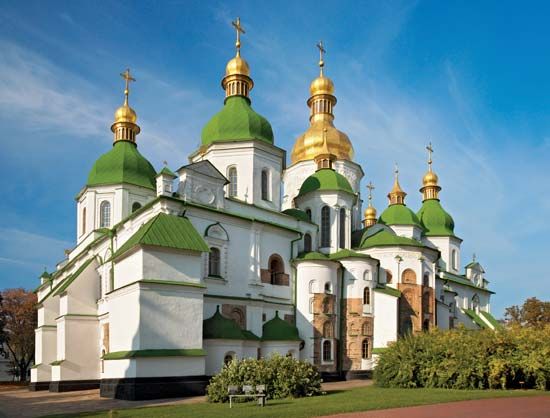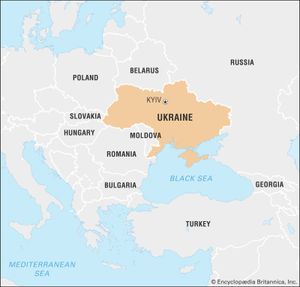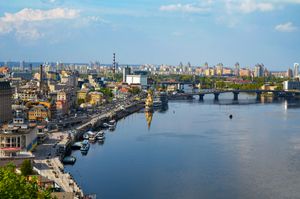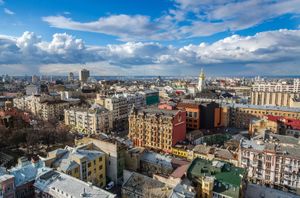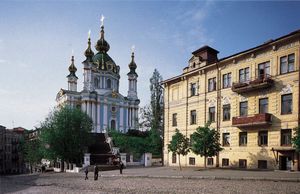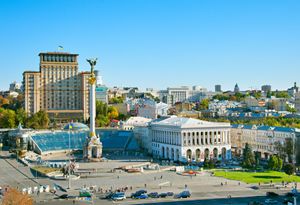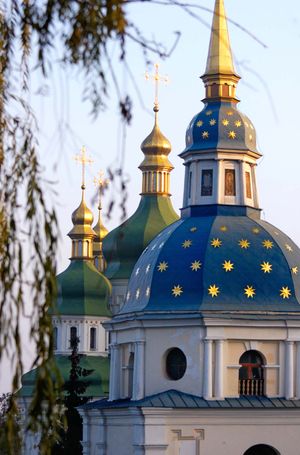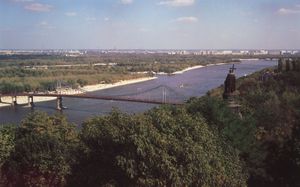Kyiv
- Also spelled:
- Kiev, Kyyiv, or
- Russian:
- Kiyev
News •
Kyiv, chief city and capital of Ukraine. A port on the Dnieper (Dnipro) River and a large railroad junction, it is a city with an ancient and proud history. As the centre of Kyivan (Kievan) Rus, the first eastern Slavic state, 1,000 years ago, it acquired the title “Mother of Rus Cities.” It was severely damaged during World War II, but by the mid-1950s it had been restored, and in the second half of the 20th century it enjoyed a well-developed economic and cultural life. The independence of Ukraine from the Soviet Union in 1991 renewed Kyiv’s status as a major European capital. Pop. (2001) 2,611,327; (2021 est.) 2,962,180.
Landscape
City site
The city stands on the Dnieper River just below its confluence with the Desna and 591 miles (951 km) from its mouth in the Black Sea. The original location was on the high and steep right (western) bank, which rises above the river in an imposing line of bluffs culminating in Batyyeva Hill, 330 feet (100 metres) above mean river level. This precipitous and wooded bank, topped by the golden domes and spires of churches and bell towers and by high-rise apartment buildings, makes the city an attractive and impressive sight from across the Dnieper. Since World War II, Kyiv has extended onto the wide, low, and flat floodplain on the left (eastern) bank.
Climate
Kyiv has a moderately continental climate. The average January temperature is 21 °F (−6 °C), and winter days with temperatures above freezing are not uncommon. In cold spells with a northerly or northeasterly airstream, temperatures may drop sharply, and an absolute minimum of −27 °F (−33 °C) has been recorded. Snow cover lies usually from mid-November to the end of March; the frost-free period lasts 180 days on average but in some years surpasses 200 days. Summers are warm, with a July average of 68 °F (20 °C) and a recorded maximum of 102 °F (39 °C). The mean annual precipitation is 25 inches (635 mm), with maximum rainfall in June and July.
City layout
The city limits enclose an area of 300 square miles (780 square km) on both banks of the Dnieper. It is divided into a number of administrative wards. The focus of Kyiv is the area of the ancient Upper Town, crowning the high bluffs of the Dnieper. Although largely of postwar construction, this central area retains its old street pattern, and most of the surviving historical and architectural monuments are located there. First among these is the cathedral of St. Sophia, now a museum. It was built in the 11th century and remains, despite certain Baroque modifications in the 18th century, one of the finest and most beautiful examples of early Rus-Byzantine ecclesiastical architecture. It has a nave and four aisles and is crowned by five domes. The interior is magnificently decorated with frescoes and mosaics; it contains the tomb of Yaroslav I, the grand prince of Kyiv during whose reign the cathedral was built.
Close by is the Baroque church of St. Andrew, designed by Bartolomeo Rastrelli and built in the mid-18th century; its site on the crest of the steep slope to the river makes it a striking landmark. Other historical relics in the central area include the ruins of the Golden Gate, also built in the 11th century in the reign of Yaroslav; the Zaborovsky Gate, built in 1746–48; and the remains of the Desiatynna Church, or Church of the Tithes, built in 989–996 by Grand Prince Volodymyr (Vladimir I).
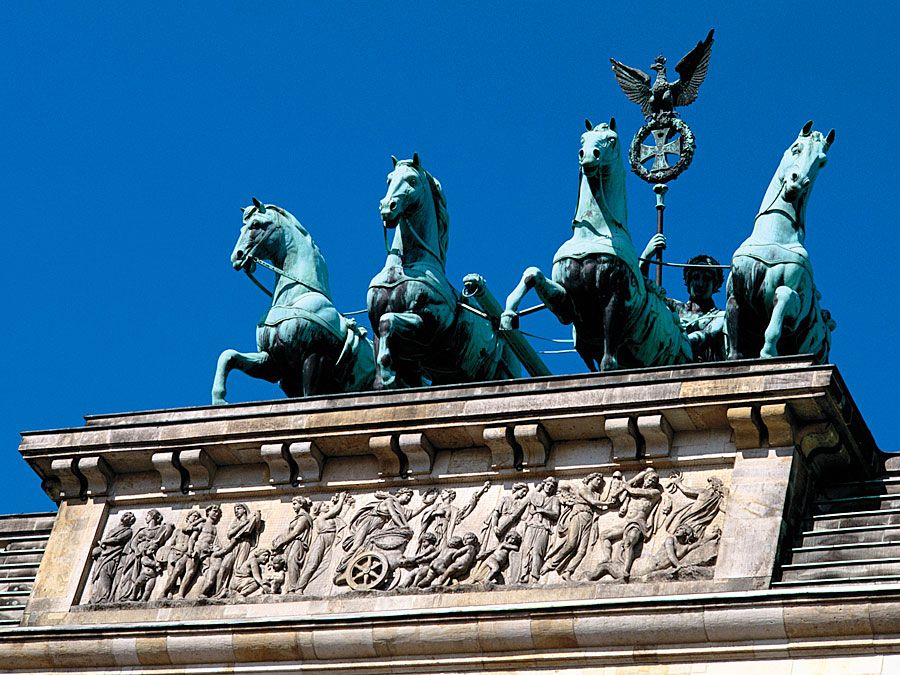
Within and immediately adjacent to the area of the former Old Town are many of the city’s museums, theatres, and public buildings as well as the principal shops. The axis of the centre is the street known as Khreshchatyk, which runs along the bottom of a small valley the sides of which have in part been landscaped with terraced gardens interspersed with tall, modern office and apartment buildings. The greenery of the gardens, the trees lining the street, the squares that it intersects—all combine with the variegated colours of brick, red and gray granites, and decorative ceramic tiles to give Khreshchatyk an attractive and colourful aspect much admired by Kyiv’s inhabitants. Perhaps the most notable public square along Khreshchatyk is Maidan Nezalezhnosti (“Independence Square”). It served as the centre of the Maidan (also called Euromaidan) protest movement that led to Ukrainian Pres. Viktor Yanukovych’s being deposed in February 2014. Among important buildings on the street is that of the city council, where the elected deputies hold their meetings.
Intersecting Khreshchatyk at right angles is the wide poplar-lined Boulevard of Taras Shevchenko, on which stands the university with its eye-catching red-washed walls. There too is the cathedral of St. Volodymyr (still in use as a church), built in 1862–96 in Byzantine style and containing impressive paintings by Viktor Vasnetsov, Mikhail Vrubel, and other artists. Notable among the many statues in central Kyiv are those that commemorate the Cossack leader Bohdan Khmelnytsky and the Ukrainian poet Taras Shevchenko.
North of the old centre is the former trading and Jewish quarter, Podil, with a rectangular pattern of streets and the old merchants’ trading exchange, the House of Contracts, built in 1817. Also north of the old centre is the river port. South of the centre is the Pecherskyy district, along the top of the riverbank. This district contains many of the principal buildings of the Ukrainian government, including the glass-domed palace, built in 1936–39, that houses the Supreme Council and the 10-story block that houses the Cabinet of Ministers. Nearby is the attractive Mariinsky Palace, built in 1747–55 for the tsaritsa Elizabeth, reconstructed in 1870, and now used for government receptions.
At the southern end of this district is the Kyiv-Pechersk Lavra (Monastery of the Caves), founded in the mid-11th century, one of the most famous and important monasteries in the history of the region. It was at the lavra that the monk Nestor helped compile the earliest surviving chronicle of the East Slavic state of Rus. The Cathedral of the Assumption (inside the walls of the monastery), blown up in 1941 under circumstances that remain uncertain, has been completely rebuilt. Trinity Church, of the same period, survives. Also within the walls are the 17th-century Church of All Saints and an impressive 18th-century bell tower rising 315 feet (96 metres). A major feature of the monastery is the system of catacombs beneath it in which the mummified bodies of early monks and saints, including Nestor, are entombed. Although it is a museum open to the public, the Kyiv-Pechersk Lavra is still in use as a monastery. South from the lavra is yet another monastery, the Vydubytsky, dating from the 11th century; it too was severely damaged in World War II but later underwent restoration.
All along the steep riverbank, fronting the Upper Town and Pecherskyy district, an attractively landscaped park has been laid out overlooking the Dnieper. With the views it affords, the park forms one of the most striking features of the city. It contains an open-air theatre, sports stadium, and restaurant, and a funicular railway climbs the 300-foot (90-metre) slope. Also within the park are many memorials. Dominating the northern end is the statue of Grand Prince Volodymyr, who brought Christianity to Rus. The statue marks the place where in 988 the people of Kyiv were baptized en masse. The southern end, called the Park of Glory, has an 85-foot (26-metre) granite obelisk rising above the grave of the Unknown Soldier and a memorial garden. Also located in the park are the grave of Gen. Nikolay Vatutin, commander of the Soviet forces that liberated Kyiv in 1943, and a rotunda marking the supposed grave of the early Varangian (Viking) chief Askold.
Around these central districts of Kyiv stretch extensive suburbs of factories and residential neighbourhoods. As low priority was given to housing during the period of Joseph Stalin’s rule, the greater part of these suburbs was built after the Soviet leader’s death in 1953. The neighbourhood units, known as microregions, consist of groupings of apartment buildings housing 2,500 to 5,000 people, together with basic services, local shops, a health centre, cinema, and primary school. Since the late 1960s the apartment buildings have usually been of 12 to 20 stories and of prefabricated construction. Most apartments have only two or three rooms, and population densities are therefore high, in the new residential developments as much as in the older central areas. The growing ownership of private cars poses problems in the provision of garage space in these new districts. A feature of development since World War II has been the rapid spread of the city on the low left (eastern) bank of the Dnieper, previously almost devoid of settlement. The left bank is linked to the main part of Kyiv by a railway bridge and by the imposing Ye. O. Paton road bridge, which is 4,920 feet (1,500 metres) long and named for its designer.
Between the neighbourhood units are substantial areas of parks and green space. These include the large botanical gardens of the National Academy of Sciences of Ukraine and the smaller university botanical gardens (established in the mid-19th century). On the city outskirts are several areas of forest, which are much used for recreation. In the south is the Holosiivsky Park, dominated by deciduous trees, and to the north are nearly 10,000 acres (4,450 hectares) of the Pushcha-Vodytsya Forest Park, mainly covered by coniferous species. A number of factors combine to make Kyiv an attractive urban centre—the site, with its sharply contrasted relief and wide views across the Dnieper, the abundance of greenery in and around the city, and the many buildings of historical interest and beauty.

